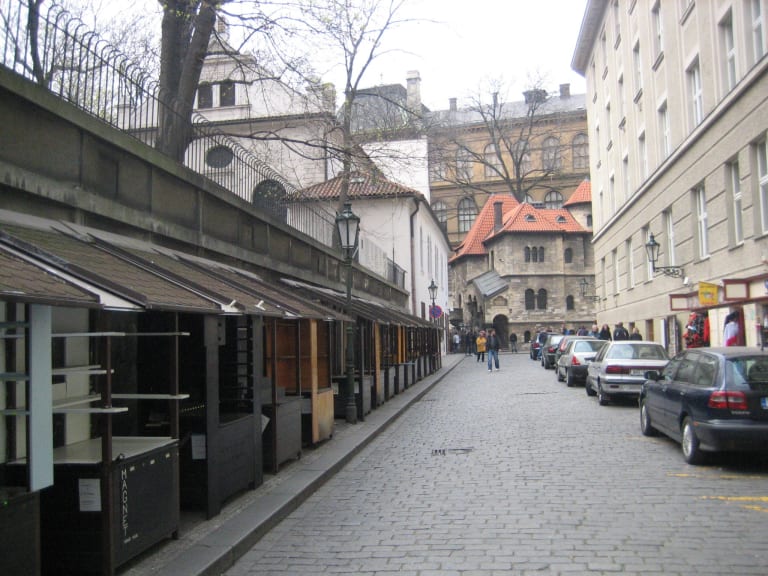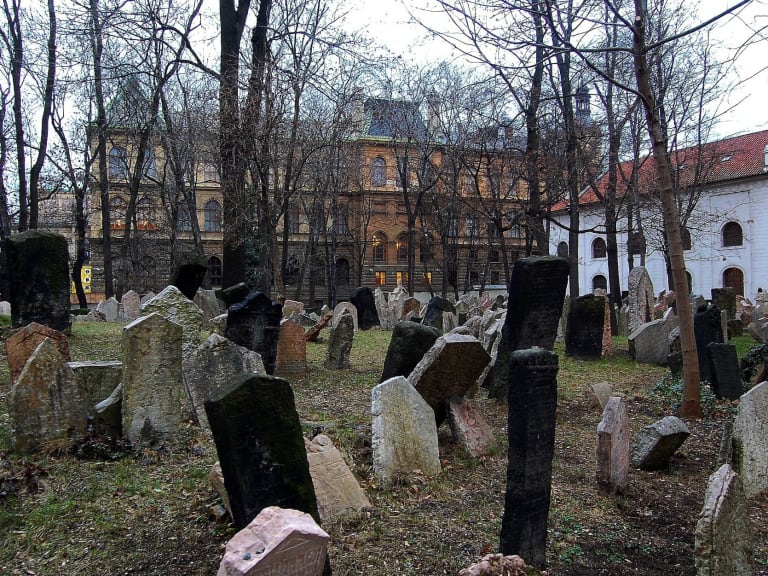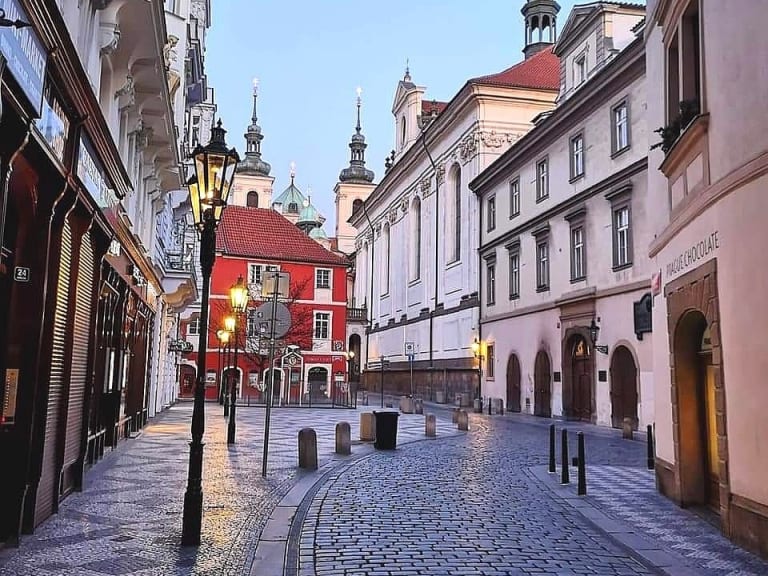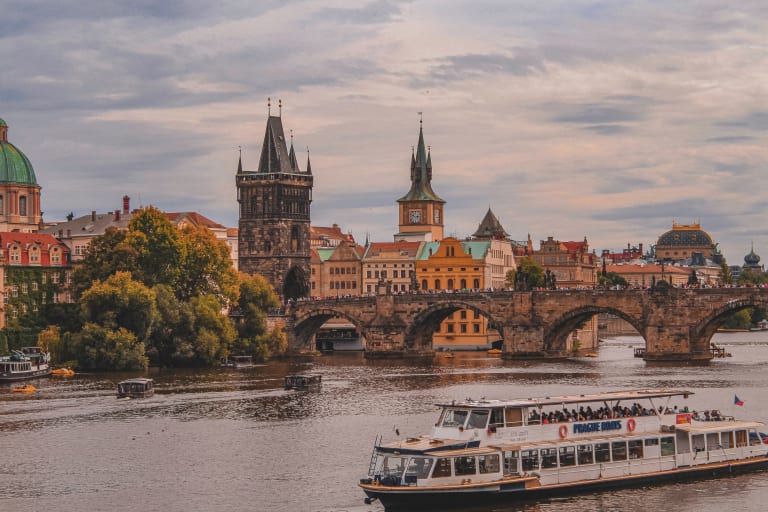More about: Prague in 1 Day: a guidebook for getting the most out of your visit
There is no denying that having only 24 hours for all that Prague offers to see and do is too little time. The city is one of the most interesting in all of Europe and it is always better to dedicate a few more days to see and get to know it better.
However, you should not be discouraged by only having one day. With a little bit of organization, waking up very early and hurrying up, it is possible to visit at least the main places that the Czech capital offers to its visitors. This itinerary includes three must-see places: the castle, the Jewish quarter and the Charles Bridge and its surroundings.
Visit Prague Castle to start your day in the city.

Given the limited time you will have available, I advise you to study beforehand how to get to Prague Castle. Once you know, keep in mind that you will have to arrive very early, both to make the most of the day and to avoid the most crowded hours. To do this, you should consult the Prague Castle opening hours beforehand.
Prague Castle is almost a small walled city in itself. Inside you will be able to see streets, a fantastic garden and buildings that you can not miss. Among the latter are the St. Vitus Cathedral, where you should pay attention to its famous St. Wenceslas Chapel and the Crown Jewels.
Depending on your time and the type of Prague Castle ticket you have purchased, it is also worth climbing the cathedral tower to enjoy the view. From the top you can see the Charles Bridge and the entire old city.
Another must-see building is the Royal Palace, where the kings of Bohemia and some Holy Roman Emperors lived. In addition, the castle grounds also house other monuments such as the White Tower, the Daliborka Tower and the Convent of St. George.
Guided tour of the castle or on your own?
To see this monument more efficiently and with information about each of its corners it may be a good idea to hire a guided tour of Prague Castle.
Obviously, the visit can also be done by purchasing tickets for free (see here the prices for the Prague Castle), but then you should measure very well the time you spend in each space and have previously consulted the history of the castle to better understand what you are seeing.
Discover the Golden Alley, one of the most charming places in Prague.

Still inside the castle complex you will find a small street that is definitely one of the most charming in the whole city: the Golden Alley.
The street is lined with several 16th century houses painted in different colors, which are nowadays occupied by stores where you can find various kinds of goods and souvenirs.
Although there are different legends about the origin of this alley, such as the one that states that it was occupied by alchemists who tried to turn metals into gold, the truth is that the houses were built to accommodate the 24 guards of the castle.
Later, the houses were occupied by several goldsmiths, which is why it received the name of Gold Alley. As a curiosity, the famous writer Franz Kafka lived for a year at number 22.
Tour Malá Strana discovering all its corners

After leaving the castle complex, the itinerary continues through one of the most interesting neighborhoods of the city: Malá Strana or Lesser Town. This district is one of the most historic in Prague and strolling through its streets means discovering wonderful places almost at every step.
The most important street in the neighborhood is Nerudova, so called because it was the residence of the writer Jan Neruda. Going down the steep slope from the castle in the direction of the Plague Column you will be able to glimpse several historic buildings and old palaces, such as the Italian embassy or Morzin palace.
One of the most beautiful points of this neighborhood is the Malá Strana square, where the church of St. Nicholas is located. From there you follow the road in the direction of Kampa Island, one of the corners with the best views of the city. Along the way you will find the famous John Lennon Wall, a mural painted by young Czechs in tribute to the singer after his murder.
Due to the lack of time it is difficult to explore Kampa park well, but it is at least worth a look at the views before continuing along the river bank in the direction of the Manes Bridge.
Surprise yourself with the narrowest street in the city

During the tour, in addition to other buildings of interest, you will find a curiosity of the city: the narrowest street in Prague. In fact, it was not originally conceived as a street, but as a firebreak between houses to prevent fires from devastating the neighborhood as had happened in 1541.
The street measures only 77 centimeters at its narrowest point and has a length of 50 meters. These characteristics meant that access had to be regulated with a traffic light so that pedestrians in both directions would not coincide.
Get lost in Josefov, Prague's Jewish Quarter

If you follow the river along the Malá Strana bank, you will reach the Mánes Bridge, where you must cross to begin your visit to Prague's Jewish quarter, called Josefov.
This quarter was formed in the Middle Ages, after the arrival of the Jewish community in Prague in the 10th century. The oldest synagogue dates back to 1270 and is one of those that can still be visited. For several centuries this neighborhood was, in fact, a ghetto from which they could hardly leave, since it was not until the nineteenth century when the rights of the Jews were recognized and they were allowed to reside in any other area.
Although you can hire a guided tour of the Jewish quarter, on this occasion the time pressure makes it difficult to see it all, so you will have to settle for visiting only some of the six synagogues that exist in the area.
- Spanish Synagogue: it was built in 1868 and its name comes from its Moorish decoration reminiscent of that of the Alhambra in Granada. Today it houses an exhibition on the life of the Jewish community.
- Pinkas Synagogue: located at the entrance of the Jewish Cemetery, this synagogue contains in its interior the names of the 77,297 Jews of the then Czechoslovakia who died at the hands of the Nazis. You will also be able to see several drawings made by children who were in the nearby concentration camp of Terezin. I advise you to note the excursion to Terezin as one of the must-sees for your next visit to the city.
- Old-New Synagogue: it is the oldest synagogue in Europe among those that still have a religious function. It is also one of the first buildings in Gothic style in Prague.
Entrance to the synagogues
There is a single ticket that entitles you to visit all the synagogues (with the exception of the Old-New, whose entrance must be purchased separately) and the Jewish Cemetery.
With the ticket you will be given a small map of the neighborhood really useful to find all the sites of interest.
Enter the Old Jewish Cemetery

Everything there is to see in the Jewish Cemetery makes it one of the most interesting places in Prague. Built in the 15th century, for 300 years it was the obligatory burial place for all the city's Jews.
The small size of the cemetery, where it is estimated that more than 100,000 people are buried, meant that the bodies had to be stacked one on top of the other.
Today some 12,000 tombstones remain, including those of Rabbi Judah Loew, creator of the Prague Golem, Rabbi David Oppenheim and mathematician, astronomer and historian David Gans.
Entrance to the Jewish Cemetery
If you have purchased the combined ticket with the synagogues you will not have to pay anything extra to visit the cemetery. In case you haven't, you can always buy an individual ticket for the tour among the graves.
Have a bite to eat in the Jewish Quarter

To recharge your batteries without wasting too much time I recommend eating in a curious place located in the Jewish quarter, the Naše Maso.
As I explained in my article about restaurants in Prague, this place is actually a butcher's shop that prepares various meat dishes on the spot so you can eat them right then and there.
The meat they sell, whether as burgers, sausages, steak tartar and other preparations, is of high quality. The only problem is its small size and the difficulty of finding a free place.
Go up to the Gunpowder Tower

Leaving the Jewish quarter behind, you enter the Staré Mesto, the old part of the city. One of the first places you can see is the Powder Tower, one of the ancient gates of the Prague wall.
This gate was the entrance used by the kings of Bohemia when they went to their coronation ceremony, so it is considered the beginning of the Royal Road that ended at the castle.
If you wish, you can climb to a viewpoint located 44 meters high, but if you then plan to climb the tower of the Old Town Square, you do not need to do so.
Immerse yourself in the beauty of the Old Town Square without rushing.

The Old Town Square is undoubtedly the most impressive space in Prague, with the permission of the castle and Charles Bridge. It can be said that all the buildings surrounding the square are really impressive and it is worth walking its perimeter calmly to enjoy them.
At the entrance to the square is the famous Tyn church, built in the fourteenth century on a small chapel existing in the same place. Gothic in style, it was a project conceived by the bourgeoisie of this area of Prague to compete with St. Vitus Cathedral, located across the river.
Note that the facade is not visible from the square, although its two impressive towers are. Inside is buried one of the most famous astronomers in history: Tycho Brahe.
In the same square you can not miss the old town hall, where the Astronomical Clock of the city, for which I recommend buying tickets in advance. The same tower that houses this clock has in its highest part, about 70 meters, a viewpoint from which you can see the entire old city.
However, the most emblematic of the building is the mentioned Astronomical Clock, the third oldest in Europe. This mechanism was added to the tower in the early fifteenth century and today it attracts hundreds of tourists every hour who try to see "The Walk of the Apostles", figures that come out of its interior as if they were parading.
Stroll along Karlova Street

After spending enough time to get a good view of the Old Town Square, it is a good idea to enter one of the most important streets in Prague, Karlova Street.
This winding pedestrian street connects the two historic districts of the city, the Stare Mesto and Malá Strana. If you have hired a tour of Prague, you will surely have passed through it on a walk that sometimes is not easy to do because of the large number of tourists.
Despite the crowds, Karlova Street is well worth a walk to observe its Gothic and Renaissance houses and stop in front of some shop windows.
The whole street is full of stores and cafes, so it can be a good place if you want to rest a while having a coffee.
During the walk there are some buildings that are worth stopping to see them more calmly. Thus, there is the first coffee shop in the city, called Golden Serpent, which opened its doors no less than in 1713 and today has been converted into a restaurant.
Similarly, at number 44 is Karlova Crystal, an impressive store specializing in Bohemian crystal items. Finally, at number 3/175, you will be able to admire the facade of the House of the Golden Wells, adorned with a fabulous baroque stucco.
Cross the Charles Bridge

No one can leave Prague without crossing at least once the Charles Bridge, the most beautiful of all the bridges that connect both banks of the Vltava River.
Among the things to see on the Charles Bridge are the baroque statues located on the sides that compete to attract the eyes with all the street artists that are usually placed in the area.
One of the advantages of crossing the bridge later is that the influx of people is usually less, although in high season the difference is minimal. Hopefully, this will allow you to stop and enjoy the fantastic views of Prague Castle. Depending on the time of day, you can even see its illuminated silhouette creating a magical sensation.
Vltava River Cruise with dinner included or ghost tour

To end this intense day of sightseeing I am going to propose you several alternatives. It all depends on how tired you are and, obviously, on your tastes.
- Strolling quietly along the banks of the river: the first option is simply to stroll along the banks of the Vltava River. On them, no matter the bank, you will always find a lot of atmosphere, as they usually gather a lot of people around them. Depending on the darkness, you can also take a walk around Střelecký ostrov, a park located on one of the small islands along the river.
- Rivercruise with dinner: one of the most romantic plans to end the day is to hire a small cruise on the Vltava that includes dinner. In addition to enjoying the food and the fantastic views, there is usually live music and dancing along the way.
- Ghost tour: Prague, with its urbanism and history, hides several legends and really gruesome events. If you are a lover of strong emotions you can take one of the tours that will take you to the darkest part of the city.
How to get around Prague

Actually, for the one-day tour the best thing to do is to walk, something that will not be a problem for you. However, in case you want to get to Prague Castle by public transport or you have to use it to return to the hotel, here I explain the options:
- Streetcar: possibly the best way to get around Prague, as it is the only means of transport that reaches some corners of the old town. You will find streetcars running 24 hours a day, although the frequency of the night lines is somewhat lower.
- Metro: although it also works very well, it has the disadvantage that it does not reach some of the most visited areas of the Czech capital, in addition to the fact that it does not have service at night.
- Buses: like streetcars, city buses operate 24 hours a day. They are the best option if you have to move to areas quite far from the center.
But if you want to make the most of your stay in the Czech capital I recommend you to buy the Prague CoolPass tourist card, which includes a tour on the tourist bus, a river cruise, tickets to 60 tourist attractions and interesting discounts.
Change money in Prague

Although the Czech Republic belongs to the European Union, the country has decided to keep its own currency, the koruna. This implies that you will have to change some money to be able to afford some payments.
My first advice is not to change at the airport, as the rate is worse than in the exchange houses in the city center and, especially, in the Jewish quarter.
A good option for a shorter stay is to pay almost everything by credit card and only change a small amount to pay for the transport ticket (the machines only accept coins), some small occasional expense or even if you have to enter a public toilet (where you usually have to pay a small amount).




